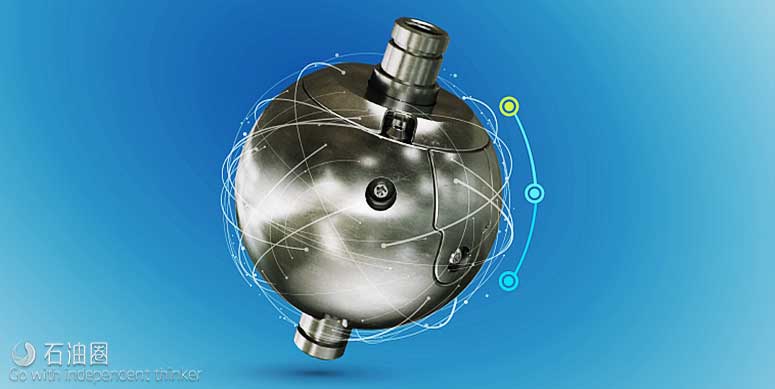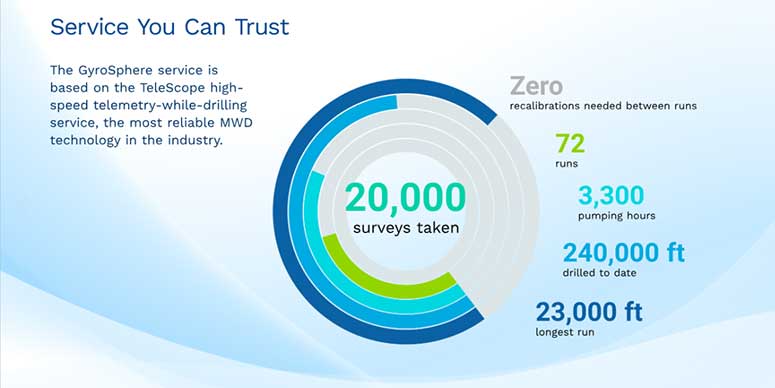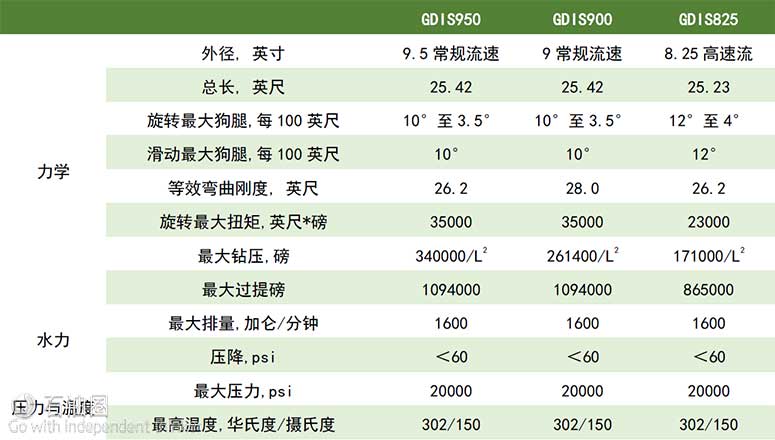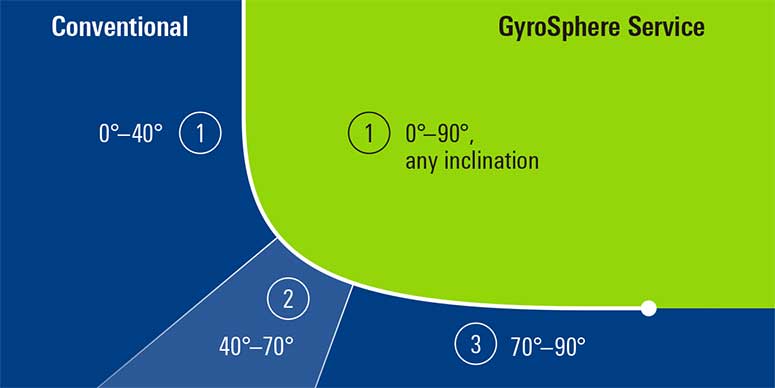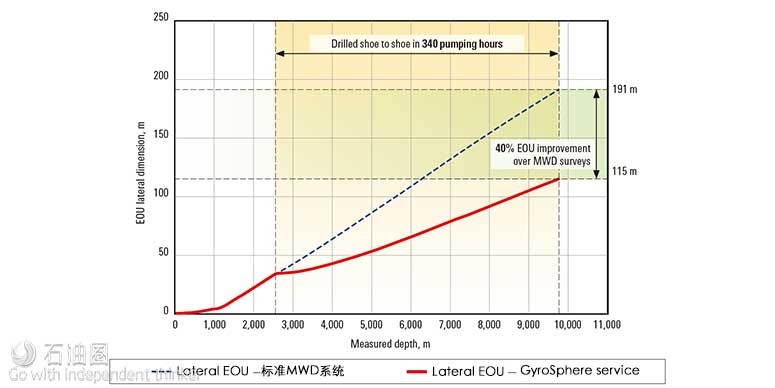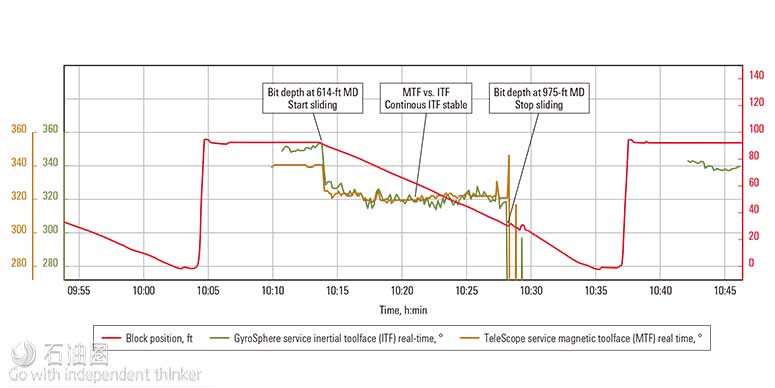The GyroSphere* MEMS-gyro-while-drilling service is the industry’s first adaptation of MEMS technology for gyro surveys in the oil field. This significantly improves gyro-surveying efficiency and reliability, as well as reduces the ellipse of uncertainty by up to 45% and enables drilling smaller targets.
Gyroscopic surveys in the oil field have not changed much over the past 20 years. Most conventional systems are sensitive mechanical devices that can be compromised by shock and vibration, which means they must be recalibrated after every single run. The GyroSphere service features a unique sensor that incorporates solidstate MEMS technology. Utilizing the Coriolis effect,? the MEMS gyro sensor uses an internal vibrating structure to determine the Earth’s rotation with respect to the sensor. This enables the GyroSphere service to determine azimuth and inertial toolface orientation when sliding with a motor. Not only can MEMS technology withstand challenging downhole conditions, including severe shock and vibration, it means the sensor can be rerun without recalibrating the tool.
Delivering big performance with microtechnology
Gyro surveys with the GyroSphere service are more transparent to drilling operations because the measurement is taken during connections and available immediately after the pumps are on, rather than having to wait 30 minutes for the data. This is because MEMS technology doesn’t need to spin up and stabilize as mechanical gyros do, so up to two surveys can be performed in the time conventional gyros take to start up for just one. The sensor is smart—it knows when to survey, and has the capabilities to report its own status.
MEMS technology doesn’t only make gyro surveying more efficient and smarter, it enables the GyroSphere service to withstand challenging downhole conditions, including severe shock and vibration. Unlike a conventional gyro apparatus that requires multiple tools, the GyroSphere service needs only its single sensor to survey at any inclination, at any depth, and at higher latitudes—all without the need for changing batteries or recalibrating between runs. This makes the GyroSphere service well suited for efficient batch-drilling operations.
1.Survey’s during connections just like regular MWD surveys
2.Superior reliability based on TeleScope service
3.Reduced ellipse of uncertainty up to 45%
MEMS Technology Explained
Sensor technology
Schlumberger adapted microelectromechanical systems (MEMS) technology to determine longitudinal and latitudinal positioning, similar to other advanced systems such as robotics, spacecraft, smart phones, and drones.
Coriolis effect
The GyroSphere service differs from mechanical gyros in that it takes its measurement using the Coriolis effect.
It uses an internal, microscale vibrating structure to ascertain the rate of planetary rotation, which varies depending on depth and latitude. That rate is then used to determined inclination, azimuth, and toolface orientation data.
Advantages
1.Provides continuous definitive gyro surveying
2.Enables single-sensor tool for any azimuth, any inclination, and in high latitudes
3.Sustains accuracy while moving equal to stationary survey quality
Timeline
The GyroSphere MEMS gyro-while-drilling-service represents the first major evolution in gyro surveying in almost 20 years.
Efficiency
ZERI additional rig time for 10 surveys with the GyroSphere service versus up to 5 hours with conventional gyro surveys.
Reliability
The GyroSphere service is based on the TeleScope high-speed telemetry-while-drilling service, the most reliable MWD technology in the industry.
GyroSphere Service Helps Improve Drilling Efficiency and Reduce Ellipse of Uncertainty, Far East Asia
An operator needed to perform a gyro survey program to TD in the 121/4?in section of a well to pinpoint and penetrate the target reservoir. This extended-reach section limited wireline gyro surveying because the downhole conditions presented risks for stuck tools while running in and out of hole, as well as an inability to run the tool far enough downhole to adequately reduce EOU. Wireline gyro surveying can be run after drilling operations are complete, because such tools need a stationary drillstring to hold orientation in the targeted survey direction. Consequently, this could add an estimated 28 hours of rig time to the operation.
Given operator requirements, Schlumberger recommended the GyroSphere MEMS gyro while drilling service. This is the first gyro surveying service to adapt a microelectromechanical system (MEMS), which increases drilling efficiency, enables transparent gyro surveying operations, and provides a better reduction of EOU.
The sensor is solid?state technology able to withstand the rigors of drilling, including shock and vibration. It is incorporated into the drillstring and completes gyro surveys during connections, and for the whole duration of the section. Being part of the drilling BHA also means that the GyroSphere service reduces the risks of stuck pipe in long laterals.
The operator deployed the GyroSphere service while drilling the 12 1/4 in section of the well, helping to provide real?time positioning with the same level of accuracy as drop gyro measurements. Indeed, by combining the gyro surveys with the regular MWD surveys, the EOU was reduced by 40%.
No additional rig time was required to complete the gyro surveys, including a full set of pull out of hole survey data for QC and data redundancy. In fact, the operator saved 28 hours of rig time. Additionally, the GyroSphere service established a record for the longest gyro survey while drilling run ever completed.
First Use of Inertial Toolface Mitigates Collision Risks in Dense Well Cluster, Reduces Rig Time
A dense well cluster in a field offshore Angola posed a high collision risk for an operator drilling a 17-in tophole section and a 121/4-in section. Magnetic toolface systems would be compromised by complex offset well proximities, and the operator needed an alternative surveying system. The drawback for conventional mechanical gyro-while-drilling systems previously deployed was that survey time in the tophole section was 20 minutes, slowing the ability to survey and make anticollision calculations. Further data inadequacies were encountered while using drop gyros at the 121/4-in section TD, which were intended to fill in the data gaps from the tophole survey. A faster, more efficient alternative was sought that would also deliver better survey data.
Schlumberger recommended the GyroSphere MEMS gyro-while-drilling service, the first adaptation of microelectromechanical systems technology for gyro surveying in the oil field. The service increases drilling efficiency and enables transparent gyro-surveying operations.
Within the service’s single sensor is solid?state technology able to withstand the rigors of drilling, including shock and vibration. It is incorporated into the drillstring and completes gyro surveys during connections and for the whole duration of the section. These capabilities provide more surveys and more reliable survey data, which is especially critical when drilling a complex field profile.
This instance is the first industry use of an inertial toolface incorporating a solid-state MEMS gyro. Using the GyroSphere service eliminated the need for drop gyros, saving at least 2 hours of rig time at section TD. Additionally, more gyro surveys were performed due the ability of the GyroSphere service to function during connections, unlike conventional mechanical gyro survey systems that can wait for up to 30 minutes to initiate surveys. In fact, the GyroSphere service reduced survey time from 20 to 0 minutes and provided the operator with the data to make better anticollision calculations. Consequently, the operator has replaced conventional gyro surveying with the GyroSphere service for the remainder of the drilling operations.

 石油圈
石油圈